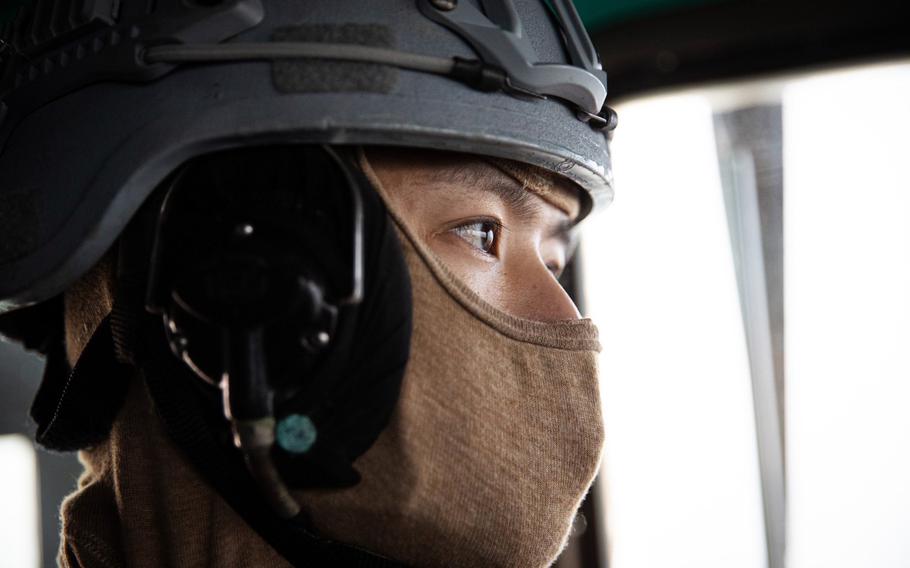
A Taiwanese service member monitors Chinese activity in the Taiwan Strait in this image posed to social media, Monday, April 10, 2023. (Taiwan Ministry of National Defense)
A large contingent of Chinese aircraft and warships remained active Tuesday in the waters around Taiwan, despite the official conclusion of their three-day exercise around the island, Taiwan’s Defense Ministry said.
Taiwan’s military reported 91 Chinese aircraft and a dozen vessels operating in the Taiwan Strait and elsewhere near the island at 6 a.m. Tuesday. Taiwanese forces continued to monitor the situation with their own aircraft, ships and missile systems, according to a series of tweets from the Taiwan Ministry of National Defense.
Beijing on Saturday began the drills, dubbed Joint Sword, which included live-fire exercises, simulated strikes on Taiwanese targets and scores of fighter jets, bombers, helicopters and warships active in the waters and skies around Taiwan.
China’s Defense Ministry intended the drills to be a “serious warning against the ‘Taiwan independence’ separatist forces colluding with external forces and provocations,” the ministry said Saturday, referring to Taiwan President Tsai Ing-wen’s meeting with House Speaker Kevin McCarthy in California last week.
Beijing considers self-governing Taiwan to be a breakaway province that must be reunited with the mainland, possibly by force.
China Foreign Ministry spokesman Wang Wenbin, at a Monday news conference, repeated the defense ministry’s warning and said Joint Sword was a “necessary move to safeguard national sovereignty and territorial integrity.”
Tsai in a Facebook post Monday night said China used her visit with McCarthy as a pretense to “launch military exercises to cause instability in Taiwan and the region.”
Taiwan’s military “will continue to hold their positions and defend the country,” and the island’s defense minister, Chiu Kuo-cheng, has been “fully authorized” to “respond in accordance with military expertise,” Tsai said in the same post.
Of the Chinese forces still active in the region on Tuesday, 54 aircraft crossed the median line of the Taiwan Strait from the southwest and southeast, according to tweets by Taiwan’s Ministry of National Defense, and eight vessels remained in the waters around Taiwan as of 11 a.m.
The aircraft and warships matched the ministry’s report from the previous day, which identified 91 aircraft and 12 vessels operating in the area as of 6 p.m. Monday.
The number of Chinese forces active around Taiwan on Monday and Tuesday were the highest ever recorded, surpassing the previous high of 71 aircraft and nine vessels reported on Dec. 25, according to an analysis by the Center for Strategic and International Studies.
A series of sorties from J-15 fighter jets from the Chinese aircraft carrier Shandong marked the first time those aircraft entered Taiwan’s air defense identification zone, according to the analysis.
Tsai’s meeting with McCarthy, and her subsequent meeting with a U.S. delegation in Taipei on Saturday, spurred a variety of other reactions from Beijing beyond Joint Sword.
The Chinese coast guard on April 5 launched a three-day “special joint patrol” of the Taiwan Strait that included cargo ship inspections ahead of Tsai’s arrival in California. However, there were no reports of inspections taking place, according to the CSIS analysis.
Tsai met McCarthy at the Ronald Reagan Presidential Library, after which Beijing on Friday imposed sanctions against top executives with the library and the Hudson Institute for providing a platform for “Taiwan independence separatist activities in the U.S.,” China’s Foreign Ministry announced that day.
The U.S. 7th Fleet on Monday sent the guided-missile destroyer USS Milius on a freedom-of-navigation operation 960 miles away in the Spratly Islands, which are claimed by China, Taiwan and four other countries.
The U.S. 7th Fleet said the Milius’ operation was only coincidental to the final scheduled day of China’s exercise around Taiwan.
China’s Southern Theater Command, in a Monday post on its official Weibo account, protested the Milius’ presence and said the ship illegally trespassed into waters that China has “indisputable sovereignty” over.